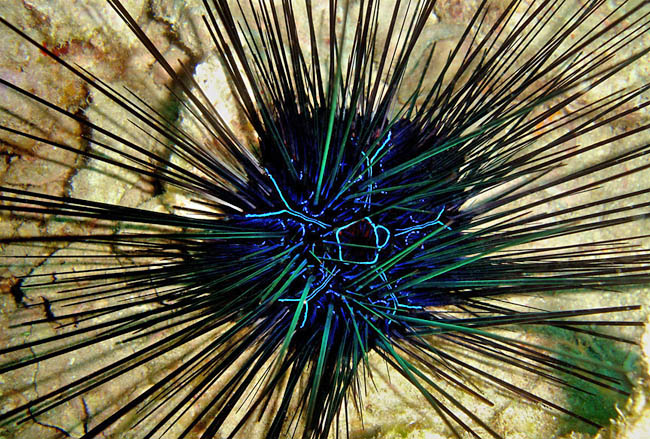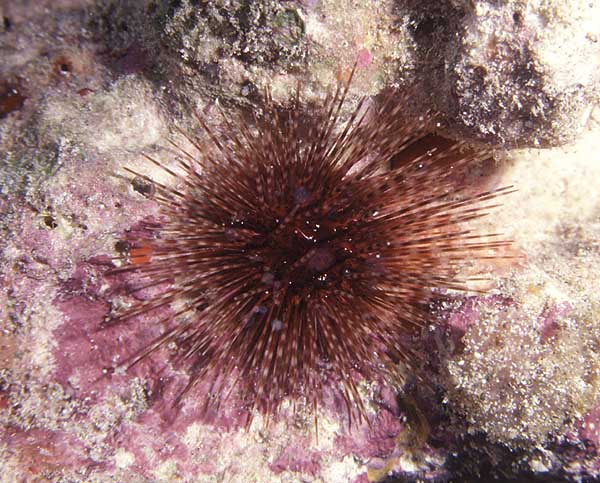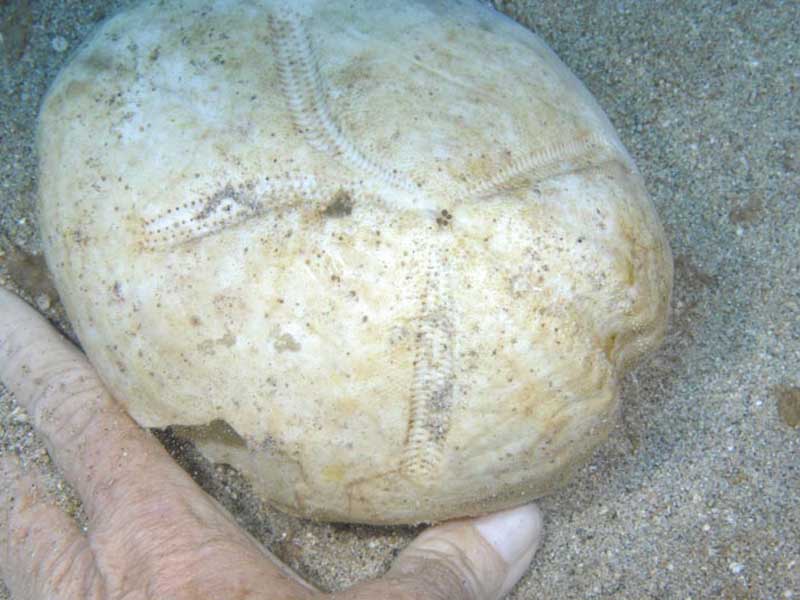|
Collector
Urchins (Tripneustes gratilla) spawning! - watch
this video by Sue Kellam, taken at Kaohe Bay, South Kona,
Hawaii, Sept. 18, 2011
|
 |
|
Diadema savignyi
(Audouin,
1809)
family Diadematidae
When viewed under bright light, this
urchin has spectacularly brilliant electric-blue lines on its upper
surface. Although formerly rare in Hawai`i, in the last few years
it has become common in some areas. The urchin above, photographed
off Maui in 2009 by veteren diver and biologist Pauline Fiene, was
the first Hawaiian specimen she had ever seen. At first she thought
it was a juvenile Diadema paucispinum because of its very
long spines, but when she saw it again 3 months later in the same
location and noticed that it hadn't grown, she began to wonder.
Eventually she found a photo of savignyi in Debelius and
Kuiter's massive
marine invertebrate atlas and realized what it was.
|
|
|
|
Diadema
sp. juveniles (upper possibly D. paucispinum; lower most
probably D savignyi)
Jim Petruzzi (http://www.myhawaiianimages.com/)
photographed unusual juvenile urchin above during a night dive at
Ulua Beach, Maui, at a depth of about 30 ft. in December 2011. Given
the very long spines it would have to be either Diadema paucispinum
or Diadema savignyi. However, it lacks any blue markings
that would clearly point to savignyi. According to urchin
expert Dr. Richard Mooi, because of the banded spines it might be
a juvenile Diadema savignyi, but not enough is known at present
to be able to tell for sure from a photograph. More photos of juvenile
long-spined urchins with size and depth information would be helpful.
Dr. Mooi says a photo from the top directly down using flash would
be best.
Update, February 2025: Luke Stribling took the photo below of what
certainly seems to be a juvenile D. savigny with clear blue
markings and faintly banded spines. Luke found the baby urchin off
Pu'u Olai, Maui, at about 40 ft. depth; the test was about pea-sized.
SInce the top photo has no visible blue markings, it is likely D.
paucispinum.

|
 |
|
Centrostephanus
asteriscus Agassiz
and Clark, 1907 ???
family Diadematidae
I found this urchin under a slab off
the Lana`i Lookout, O`ahu, at about 40 ft. Sea urchin specialist
Dr. Richard Mooi of the California Academy of Sciences tentatively
identified it from a slide as possibly belonging to the genus Centrostephanus.
The Bishop
Museum species list lists Centrostephanus asteriscus
as the only member of the genus present in Hawai`i. Since it is
seen so infrequently at scuba diving depths it's possible that its
center of population lies in deep water. I saw another one once,
off Makua, at about 60 ft.. It had an urchin shrimp in it.
Cory Pittman
writes:
I was scanning
the recent entries on your site and noticed the photo of Centrostephanus
asteriscus. I've also seen it twice. Once was a lone individual
under rubble at Honolua bay (around 40-50 ft). The other time was
a pair in a hole in rubble that the black coral divers had knocked
off a freshly collected colony at the Lahaina docks. Presumably,
those came from around 200 ft which would support the suggestion
of a deeper distribution.
|
 |
|
Metalia
sternalis Lamarck,
1816
family Brissidae
This irregular urchin test was sitting on
the sand at about 50 ft. at Makua, O`ahu. It was larger than most
other Hawaiian species except the common Brissus latecarinatus,
but it appeared to be different. I sent the photo to Dr. Richard
Mooi at the California Academy of Sciences. He replied:
The
reason that the big urchin is different from B. latecarinatus
is that it seems to be a good match for Metalia sternalis.
Since some of the identification depends on things like pedicellariae
and pore-pair counts, it's a little difficult to wing it from the
photo. However, gross matching with sources other than Mortensen
(who has remarkably poor image coverage of this important echinoid)
strongly suggests M. sternalis (Lamarck, 1816).
|
|




